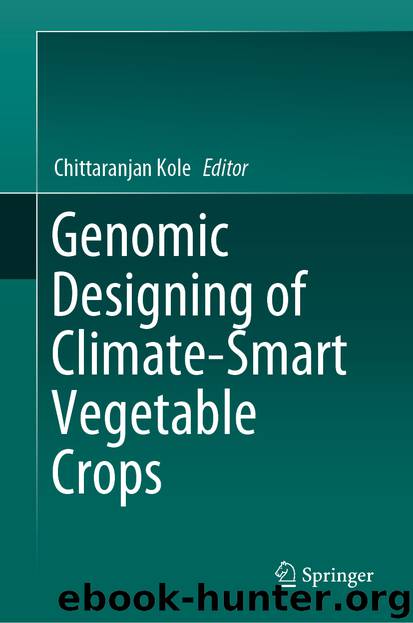Genomic Designing of Climate-Smart Vegetable Crops by Chittaranjan Kole

Author:Chittaranjan Kole
Language: eng
Format: epub
ISBN: 9783319974156
Publisher: Springer International Publishing
Various numbers of genes and micro-RNAs (miRNAs) are involved in the regulation of flowering time, which help us to understand the involvement of these factors at the molecular level. Mainly, the photoreceptor proteins (phytochrome and/or cryptochrome) are controlling the photoperiodism, which is responsible for sensing red/far-red and blue light, respectively (Más et al. 2000). Photoperiod requirements are defined as either long day (LD) or short day (SD) with respect to the length of time of daylight. This photoperiod signal plays vital role in the floral development of several plant species, which is related to the annual cyclical seasonal changes, LD, coinciding with the spring and summer seasons, and SD, associated with the autumn and winter seasons, respectively (Corbesier and Coupland 2005).
Vernalization is defined as “the acquisition or acceleration of the ability to flower by a chilling treatment.” In A. thaliana, the prolonged exposure to cold will decrease the FLOWERING LOCUS C (FLC) expression, which acts as a floral repressor by inhibiting the activation of a set of genes required for transition of the apical meristem to a reproductive state (Kardailsky et al. 1999; Kobayashi et al. 1999; Michaels and Amasino 1999; Sheldon et al. 1999; Lee et al. 2000; Samach et al. 2000; Hepworth et al. 2002). Vernalization is an example of temperature-accelerated flowering (Song et al. 2012). When other specific conditions are met, including the presence of certain photoperiods and ambient temperatures, and vernalization, flowering only takes place many weeks or even months later (Kim et al. 2009).
B. rapa and B. oleracea show different responses to vernalization; B. rapa responds to seed vernalization, whereas B. oleracea requires plant vernalization (Lin et al. 2005). In seed-vernalization-responsive type, plants can sense low temperatures during seed germination. On the other hand, in plant-vernalization-responsive type, plants need to reach a certain developmental stage before they become sensitive to low temperatures (Friend 1985). In the plant-vernalization-responsive type, plants grow vegetative in the first year and flower in the following year after winter. B. napus is an important oilseed crop; natural variation in flowering time in response to vernalization was characterized into three groups (spring, winter, and semi-winter type) (Raman et al. 2016). Spring-type varieties are annual type generally seeded in spring and complete their life cycle in a single growing season without vernalization; winter (biennial) types have an obligate requirement usually seeded in the fall and complete development in the following spring under prolonged period of cold temperature. Semi-winter types are sown before winter, which gives flower after winter.
Download
This site does not store any files on its server. We only index and link to content provided by other sites. Please contact the content providers to delete copyright contents if any and email us, we'll remove relevant links or contents immediately.
| Automotive | Engineering |
| Transportation |
Whiskies Galore by Ian Buxton(40873)
Introduction to Aircraft Design (Cambridge Aerospace Series) by John P. Fielding(32388)
Small Unmanned Fixed-wing Aircraft Design by Andrew J. Keane Andras Sobester James P. Scanlan & András Sóbester & James P. Scanlan(32167)
Craft Beer for the Homebrewer by Michael Agnew(17488)
Turbulence by E. J. Noyes(7104)
The Complete Stick Figure Physics Tutorials by Allen Sarah(6673)
Kaplan MCAT General Chemistry Review by Kaplan(6099)
The Thirst by Nesbo Jo(5834)
Bad Blood by John Carreyrou(5816)
Learning SQL by Alan Beaulieu(5464)
Weapons of Math Destruction by Cathy O'Neil(5094)
Man-made Catastrophes and Risk Information Concealment by Dmitry Chernov & Didier Sornette(4799)
iGen by Jean M. Twenge(4726)
Digital Minimalism by Cal Newport;(4657)
Life 3.0: Being Human in the Age of Artificial Intelligence by Tegmark Max(4554)
Audition by Ryu Murakami(4139)
Electronic Devices & Circuits by Jacob Millman & Christos C. Halkias(4082)
1,001 ASVAB Practice Questions For Dummies by Powers Rod(4070)
Pale Blue Dot by Carl Sagan(4054)
